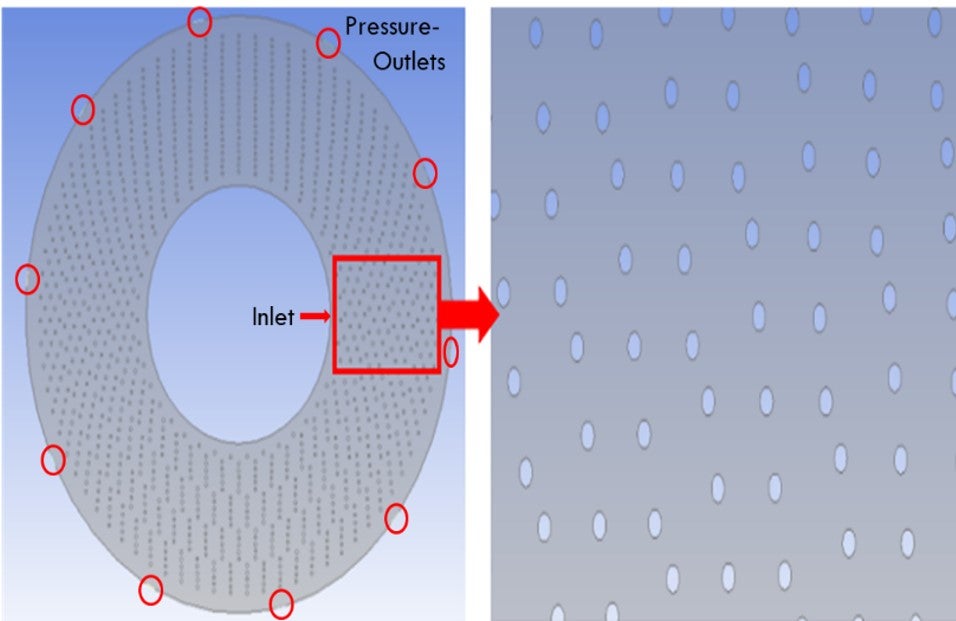-
-
August 14, 2022 at 4:49 pm
abdul.zahir
SubscriberI am trying to study the hydrodynamics of rotating system. Previously, I have run the CFD simulations without using the transport model and the used models were VOF and SST k omega model. and the contours were as follow (one example)
But to study the mass transfer performance of the same system, I have used the Linearized mass transfer UDF most likly to the one in the UDF manual. To use mass transfer I was to use the mass transport model by using mixture template. So that I can monitor the concetration of the required specie at the outlet. There is nothing in the UDF that can change the hydrodynamics of the system. But I am geting the contours like follow
Which is abnormal or the one which is wrong. The convergance is good just. I have tried it with different turbulence models, grid numbers, Methods, Multigrid settings but the contours are not changing. What could be the potential cause of this issue.
Your kind reposnse in this regard will be highly appreciated.
Thank you
-
August 16, 2022 at 2:29 pm
Rob
Forum ModeratorWhat are you actually doing? Which models, and what interactions?
-
August 16, 2022 at 3:10 pm
abdul.zahir
SubscriberI am trying to study the mass transfer performance and the hydrodynamics of the rotating packed bed reactor using VOF multiphase, SST-k omega and the reference frame models.
-
August 17, 2022 at 12:37 pm
Rob
Forum ModeratorDo you have sufficient mesh to resolve every droplet/bubble in the system? You may want to read up on how the VOF model works, and then decide if it's still the correct choice.
-
August 22, 2022 at 4:34 pm
abdul.zahir
SubscriberThe first image is also the mine one which I got during thr hydrodynamic study and is consistent with the working of the reactor and also match with the reported results in literature.
With the same case filw, when i use the mass transfer UDF the hydrodynamics becomes abnormal. This is actually the problem
-
-
August 22, 2022 at 9:18 am
DrAmine
Ansys EmployeeVOF is geomertical / algebraic construction method to get the morphology of the free surface: it relies on very good mesh resolution. No mesh resoluton-> no meaningful results.
-
August 22, 2022 at 4:36 pm
abdul.zahir
SubscriberDuring the hydrodynamic study, I found the mesh of 0.43M sufficient for the accurate prediction of results. However, for the verification, I have used the mesh quality upto 0.9M but the results are still same (abnormal).
-
-
August 23, 2022 at 5:58 am
DrAmine
Ansys EmployeeCan you explain more: what is rotating? Where is the outlet? Which models have been used? What are you trying to build-up with the mass transfer? Which phases are present?
-
August 23, 2022 at 6:14 am
abdul.zahir
SubscriberThis
This is the actually geometry. The inlet is rotating in a clock wise direction with respect to the inner packing (in circular rings). The whole geometry was initially filled with carbon dioxide and the solvent, i.e., Potasium carbonate is injected into the reactor through the inlet. The mass transfer UDF is hook to study the efficiency of the reactor to assist the absorption of CO2 in to K2CO3. To model the rotation of the inlet the Reference fram model was employed in combination with the VOF and SST-Komega model.
To study the mass transfer of CO2 in the K2CO3, species transport model was enabled. The inlet fluid (K2CO3) was changed to mixture template (CO2 and K2CO3) with K2CO3 mass fraction of 1 to ensure only K2CO3 is only injected into the reactor. The purpose of CO2 in the mixture template is only to monitor in concentration of CO2 in the mixture template at the outlet.
With transport model disabled and when K2CO3 is injected alone (not as mixture template), the hydrodynamics are normal as the reported literature but with using the mixture template the hydrodynamics become abnormal even though the mass fraction of CO2 in the mixture template at the inlet was set to 0.
This is actually the main problem. If guide in this regard.
-
-
August 23, 2022 at 3:02 pm
Rob
Forum ModeratorThe problem with the VOF model for this application is that you're tracking the free surface. If you don't have enough addition of the second phase the solver may not track it, or may fail to register it's existance. Hence my earlier comment regarding whether VOF was the correct choice.
-
August 24, 2022 at 5:58 am
DrAmine
Ansys EmployeeI still did not get why VOF is required here: are you changing the state of the mixture components?
-
- The topic ‘Abnormality in Contour of Volume fraction.’ is closed to new replies.



-
3587
-
1193
-
1086
-
1068
-
952

© 2025 Copyright ANSYS, Inc. All rights reserved.

.jpg)
.jpg)







